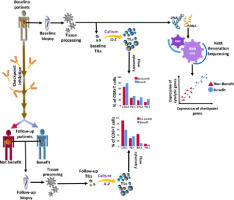当前位置:
X-MOL 学术
›
Cytotherapy
›
论文详情
Our official English website, www.x-mol.net, welcomes your
feedback! (Note: you will need to create a separate account there.)
Common phenotypic dynamics of tumor-infiltrating lymphocytes across different histologies upon checkpoint inhibition: impact on clinical outcome
Cytotherapy ( IF 3.7 ) Pub Date : 2020-04-01 , DOI: 10.1016/j.jcyt.2020.01.010 Vinicius Araujo B de Lima 1 , Annie Borch 2 , Morten Hansen 3 , Arianna Draghi 3 , Iben Spanggaard 1 , Kristoffer Rohrberg 1 , Sine Reker Hadrup 2 , Ulrik Lassen 1 , Inge Marie Svane 3
Cytotherapy ( IF 3.7 ) Pub Date : 2020-04-01 , DOI: 10.1016/j.jcyt.2020.01.010 Vinicius Araujo B de Lima 1 , Annie Borch 2 , Morten Hansen 3 , Arianna Draghi 3 , Iben Spanggaard 1 , Kristoffer Rohrberg 1 , Sine Reker Hadrup 2 , Ulrik Lassen 1 , Inge Marie Svane 3
Affiliation

|
BACKGROUND
Immune checkpoint inhibitors (ICIs) have revolutionized the cancer therapeutic landscape and our perception of interactions between the immune system and tumor cells. Despite remarkable progress, disease relapse and primary resistance are not uncommon. Understanding the biological processes that tumor-infiltrating lymphocytes (TILs) undergo during ICI, how this affects the tumor microenvironment (TME) and, ultimately, clinical outcome is, therefore, necessary to further improve treatment efficacy. AIM
In the current study, we sought to characterize TILs from patients with metastatic solid tumors undergoing ICI correlating flowcytometric findings with clinical outcome. METHODS
In total, 20 patients with 10 different metastatic solid tumors treated with ICIs targeting programmed-cell death-1 (PD-1)/PD-L1 axis were included in this study. The phenotype of T cells deriving from biopsies obtained prior to treatment initiation and on-treatment was investigaded. Analyses were focused on T cells' degree of differentiation and activity and how they correlate with transcriptomic changes in the TME. RESULTS
Data indicate that patients benefitting from ICIs accumulate CD8+central memory T cells. TILs developed an effector-like phenotype over time, which was also associated with a cytolytic gene signature. In terms of modulation of T-cell responses, we observed that high expression of checkpoint molecules pre-treatment (i.e., PD-1, lymphocyte activation gene-3 [LAG-3], B and T-lymphocyte attenuator [BTLA] and T-cell immunoglobulin and mucin domain containing-3 [TIM-3]) was associated with similar gene signature and correlated to treatment benefit. Increasing expression of LAG-3 and BTLA in the CD8 compartment and their co-expression with PD-1 during treatment were, however, a common feature for patients who failed to respond to ICIs. CONCLUSIONS
Besides identifying immune profiles suggestive of response to ICI, our results provide a more nuanced picture regarding expression of checkpoint molecules that goes beyond T-cell anergy.
中文翻译:

检查点抑制后不同组织学肿瘤浸润淋巴细胞的常见表型动态:对临床结果的影响
背景免疫检查点抑制剂 (ICI) 彻底改变了癌症治疗领域以及我们对免疫系统与肿瘤细胞之间相互作用的看法。尽管取得了显着进展,但疾病复发和原发性耐药并不少见。因此,了解肿瘤浸润淋巴细胞 (TIL) 在 ICI 期间所经历的生物学过程、这如何影响肿瘤微环境 (TME) 以及最终的临床结果对于进一步提高治疗效果是必要的。目的 在当前的研究中,我们试图表征接受 ICI 的转移性实体瘤患者的 TIL,将流式细胞术结果与临床结果相关联。方法 总共有 20 名患有 10 种不同转移性实体瘤的患者,这些患者接受了靶向程序性细胞死亡-1(PD-1)/PD-L1 轴的 ICI 治疗。研究了从治疗开始前和治疗中获得的活组织检查得到的 T 细胞的表型。分析的重点是 T 细胞的分化和活性程度,以及它们如何与 TME 中的转录组变化相关。结果 数据表明,受益于 ICI 的患者积累了 CD8+中枢记忆 T 细胞。随着时间的推移,TILs 产生了一种效应器样表型,这也与细胞溶解基因特征相关。在 T 细胞反应的调节方面,我们观察到检查点分子预处理(即 PD-1、淋巴细胞激活基因-3 [LAG-3]、B 和 T 淋巴细胞衰减器 [BTLA] 和 T -细胞免疫球蛋白和含粘蛋白结构域-3 [TIM-3]) 与相似的基因特征相关,并与治疗获益相关。然而,治疗期间 LAG-3 和 BTLA 在 CD8 区室中的表达增加以及它们与 PD-1 的共表达是对 ICI 没有反应的患者的共同特征。结论 除了确定对 ICI 有反应的免疫特征外,我们的结果还提供了一个关于检查点分子表达的更细致的图片,超出了 T 细胞无反应性。
更新日期:2020-04-01
中文翻译:

检查点抑制后不同组织学肿瘤浸润淋巴细胞的常见表型动态:对临床结果的影响
背景免疫检查点抑制剂 (ICI) 彻底改变了癌症治疗领域以及我们对免疫系统与肿瘤细胞之间相互作用的看法。尽管取得了显着进展,但疾病复发和原发性耐药并不少见。因此,了解肿瘤浸润淋巴细胞 (TIL) 在 ICI 期间所经历的生物学过程、这如何影响肿瘤微环境 (TME) 以及最终的临床结果对于进一步提高治疗效果是必要的。目的 在当前的研究中,我们试图表征接受 ICI 的转移性实体瘤患者的 TIL,将流式细胞术结果与临床结果相关联。方法 总共有 20 名患有 10 种不同转移性实体瘤的患者,这些患者接受了靶向程序性细胞死亡-1(PD-1)/PD-L1 轴的 ICI 治疗。研究了从治疗开始前和治疗中获得的活组织检查得到的 T 细胞的表型。分析的重点是 T 细胞的分化和活性程度,以及它们如何与 TME 中的转录组变化相关。结果 数据表明,受益于 ICI 的患者积累了 CD8+中枢记忆 T 细胞。随着时间的推移,TILs 产生了一种效应器样表型,这也与细胞溶解基因特征相关。在 T 细胞反应的调节方面,我们观察到检查点分子预处理(即 PD-1、淋巴细胞激活基因-3 [LAG-3]、B 和 T 淋巴细胞衰减器 [BTLA] 和 T -细胞免疫球蛋白和含粘蛋白结构域-3 [TIM-3]) 与相似的基因特征相关,并与治疗获益相关。然而,治疗期间 LAG-3 和 BTLA 在 CD8 区室中的表达增加以及它们与 PD-1 的共表达是对 ICI 没有反应的患者的共同特征。结论 除了确定对 ICI 有反应的免疫特征外,我们的结果还提供了一个关于检查点分子表达的更细致的图片,超出了 T 细胞无反应性。











































 京公网安备 11010802027423号
京公网安备 11010802027423号